
Concluding part of the post, Forum Romanum: A Roman Holiday – Travels in Rome.
Forum Romanum

Located to the west of the Colosseum is the birthplace of the Roman civilization. Walking down Via di Fori Imperiali, we turn left and go down the hill to visit ‘the most famous meeting place in the world.’ The political and economic hub of the ancient Roman Republic was originally a valley between the Palatine and Capitoline hills. This marshy area was drained in the 6th century BC by constructing an enormous sewer called the “Cloaca Maxima” and developed as the center of Roman public life.

Important structures like law courts, temples, memorials were built during the period of the Roman Republic. The word “Forum” in Latin denotes a marketplace and is derived from “ferre” which means ‘to carry’. There were different fora for different wares like Forum Boarium(cattle market), Forum Olitorium (vegetable market), Forum Piscarium (fish market), Forum Vinarium (wine market) etc. The Forum Magnum (large marketplace) later came to be known as Forum Romanum and became the focal point of commerce, politics, religion, and social life.
Tempio del Divo Giulio
Walking down to the main square of the Forum, we come to the temple dedicated to Julius Caesar. He was assassinated on the Ides of March in 44 B.C. by Cassius, Brutus and other senators who accused him of becoming a dictator. The shrine which is also known as the Temple of the Comet star was built by his grand-nephew and heir Augustus Caesar. Original temple is now in ruins but a semi-circular apse marks the site of his cremation.
The appearance of a comet during the games organized by Augustus sometimes later was taken as the soul of Julius Caesar who had ascended to heaven. Augustus used the cult ofDivus Julius and got coins minted in his name to consolidate his own power. The ruins of the shrine are scattered on the ground in front of the apse. Nearby is the Rostrum from where Mark Antony delivered his famous speech and read out the Will of Julius Caesar after the assassination. I could imagine the dramatic funeral scene as Antony’s speech immortalized by Shakespeare in his play “Julius Caesar” rang in my ears – “Friends, Romans, countrymen, lend me your ears; I come to bury Caesar, not to praise him…..”
Tempio di Dioscuri

The three imposing marble columns of the Temple of Castor and Pollux remind us of the cult of the divine twins or Dioscuri. According to legend, the divine twins led the Romans to victory against the Latin tribes at Lake Regillus in the 5th century B.C. They appeared in the Forum where they watered and washed their horses at the spring of Juturna near the temple of Vesta.
Basilica Julia
The ruins of the foundations of Basilica Julia are scattered over a large rectangular area. This was once a huge ornate structure built by Julius Caesar after he subjugated the Gallic tribes in 1st century B.C. It was completed by Augustus after Caesar’s death. The basilica housed law courts and administrative offices.
Basilica Aemilia

The ruins of Basilica Aemilia remind us of a bygone era when a ‘basilica’ was not a church but a public building which served an official and judicial function. The Basilica Fulvius Aemilia was built on the site of Tabernacle in ancient times. These were shops built of bricks and rented out to tenants by the state which indicates that the site was also a market-place. These tabernacles were later turned over to argentarii or money changers and bankers. Their business was destroyed by fire in the 3rd century B.C. These tabernacles were later rebuilt as Argentaria novae. The Roman censors Fulvius and Aemilius built the basilica in the 2nd century B.C. Many changes were made to this basilica over the centuries.
Curia Julia
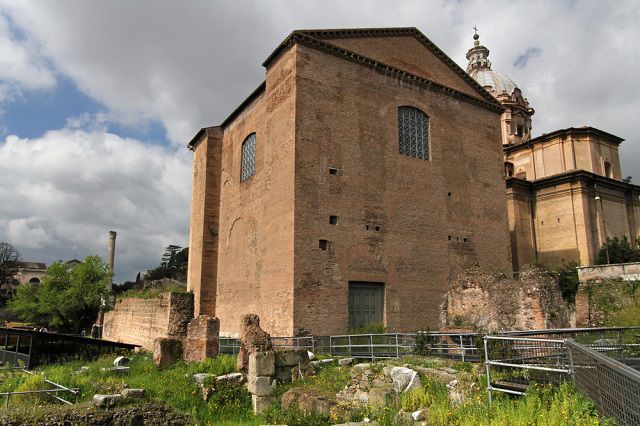
Built by Julius Caesar, this was the senate-house of the Roman Republic. After it was destroyed in a fire, Diocletian restored the building in the 4th century and the brick facade survives even today. This structure is also known as Chiesa di Sant’Adriano al Foro dedicated to the Christian martyr Saint Hadrian of Nicomedia. In the 7th century, it was converted into the church of Saint Hadrian by Pope Honorius I. The Italian government acquired this and an adjacent convent in 1922 and deconsecrated it restoring it as an ancient monument. But many of the frescoes were destroyed or damaged during the restoration. The dome of the Chiesa di Santi Luca e Martina rises adjacent the Curia. This is dedicated to Saint Martina, a Christian martyr of the 3rd century. The church was rebuilt in the 17th century.
Arco di Settimio Severo

The three-way marble arch of Septimius Severus was built in the 3rd century to commemorate the victories of Emperor Septimius Severus and his sons over the Parthians in the eastern provinces of the Roman Empire. Nearby stands a tall Corinthian column-‘Colonna di Phocas’ dedicated to the Byzantine emperor- which once supported a gilded statue. The Column of Phocas is the last honorary monument constructed in the Forum. Phocas is also remembered as the ruler who bequeathed the pagan temple Pantheon to the Catholic Church.
The Tabularium
The Tabularium is the official archive of ancient Rome where tabulae or clay tablets with inscriptions were stored. It is a towering structure which rises on the slope of the Capitoline hill forming a dramatic background to the Forum. It was built in the 1st century during the time of Sulla and renovated by Claudius. The upper-story was demolished in the 17th century to accommodate the Palazzo Senatorio designed by Michaelangelo.
Tempio di Saturno
The Temple of Saturn is dedicated to the Roman god of agriculture and wealth. In ancient times, the festival of Saturnalia held in December celebrated the golden age of Saturn with great revelry. According to Roman mythology, Saturn was the original ruler of the Capitoline hill which was called Mons Saturnius. Only the front portico with its eight granite columns survives today. The public treasures of gold and silver used to be safeguarded in the Aerarium or the treasury. The official records and the state insignia were also housed here.

We retrace our steps on the ‘via sacra’ or ‘the sacred way’ that leads from the Capitoline hill, passing through the Forum towards the Colosseum. This central street was witness to triumphal marches and ceremonial parades in ancient Rome. It is at a lower level than many monuments because of archaeological excavations.
Tempio di Antonino e Faustina

The complicated history of Rome is reflected in this gigantic structure with a church behind the tall marble columns. Antoninus Pius dedicated this temple to his wife Faustina in the 2nd century. He too was deified after his death. The remains of the temple were converted into the church of Saint Lorenzo of Miranda in the 7th century. The pillared portico of the temple is raised on a high platform of large peperino blocks. Deep grooves on the Corinthian columns are believed to be caused by the siege and pillage of the Visigoths in the 5th century.
Tempio del Divo Romulo

The pagan temple of Romulus was built by Maxentius in the 4th century to deify his deceased son Valerius Romulus. It is circular in design and the original bronze doors, set between two columns of porphyry which support a marble architrave, have turned green with time. The door serves as a vestibule to the medieval church of Saints Cosmas and Damian which can be accessed through an entrance on Via dei Fori Imperiali. These saints were twin Christian martyrs, venerated as physicians who served the poor without any payment.
Tempio di Vesta and Casa delle Vestali
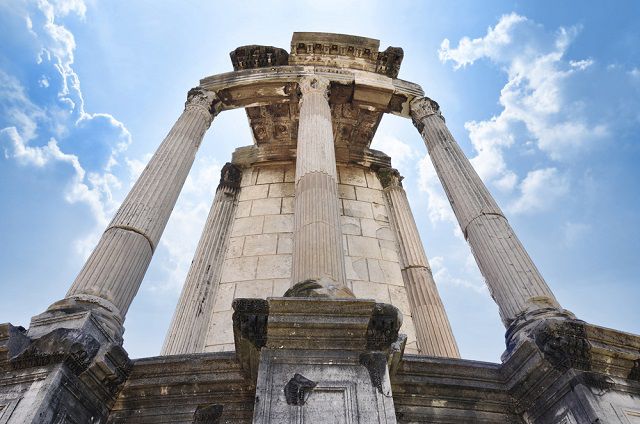
The circular temple of Vesta protected the sacred fire of Vesta, the goddess of the hearth. The goddess also symbolized Mother Earth and ensured a good harvest. Six Vestal virgins from noble families were handpicked by the high priest to safeguard the eternal fire. They enjoyed high status in Roman society but their privileged position came at a high cost. The Vestales had to maintain their chastity for a period of 30 years when they tended to the sacred fire. If the flame went out, the priestess responsible would be flogged. Loss of chastity was punishable by death and she would be starved to death in a tomb!

At the foot of the Palatine hill, a large three-storied building rises behind the temple of Vesta. It is centered on an elongated atrium or court with rectangular pools. This served as the House of the Vestal Virgins until the 4th century when the cult was suppressed.
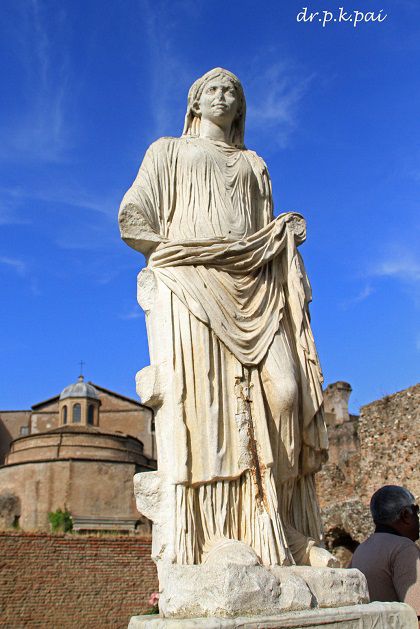
It was later used as an imperial office and the statues in the atrium were removed. They are now on display along the Via Sacra.
Basilica di Massenzio (Basilico Nova)

This is the largest building in the Forum built in the 4th century but only a massive three vaulted structure remains. This was started by Maxentius but was completed by Constantine who overthrew him. The Roman engineers perfected the technique of supporting the roof with huge arches instead of columns. This basilica design with its large interior spaces was later adopted in large churches. The southern and central sections were destroyed by an earthquake in the 9th century. This basilica hosted the wrestling events of the 1960 summer Olympics.
Arco di Tito

This gigantic triumphal arch was built by Domitian in the 1st century A.D. to commemorate the victory of his brother Titus over the Jewish rebels. The underside of the huge arch is deeply coffered. A bas-relief on the arch depicts the triumphal return of the Roman army carrying treasures looted from the Temple of Jerusalem. The panel opposite depicts Titus riding a chariot drawn by four horses accompanied by Victoria, the goddess of victory. Another relief on the vault depicts the ‘apotheosis’ or the deification of Titus who is carried to the gods on the back of an eagle. The Arch of Titus has inspired many modern arches such as the ‘Arc de Triomphe’ in Paris and the ‘India Gate’ in Delhi.
We catch glimpses of the Colosseum through the trees that line via sacra as we pass through the Arch of Titus and move towards the Piazza del Colosseo. Our journey has now come full circle. I am reminded of the French proverb – ‘Rome ne s’est pas faite en un jour’ which means Rome was not built in a day. This was, after all, a city which lent its name to an empire. With a history spanning more than two millennia, each stone in Rome has a story to tell.
Recommend you read following part 1 as well.


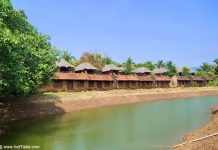

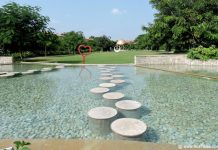









How difficult is the language barrier?
This is a guest post Amit. Will let you know once I have been there….
I always find reading about the historical places as interesting as visiting them! The history, the stories are captivating. Great post!
Thanks Neha. I am yet to go to Rome, but Sucheta Di made sure it visited my blog earlier.